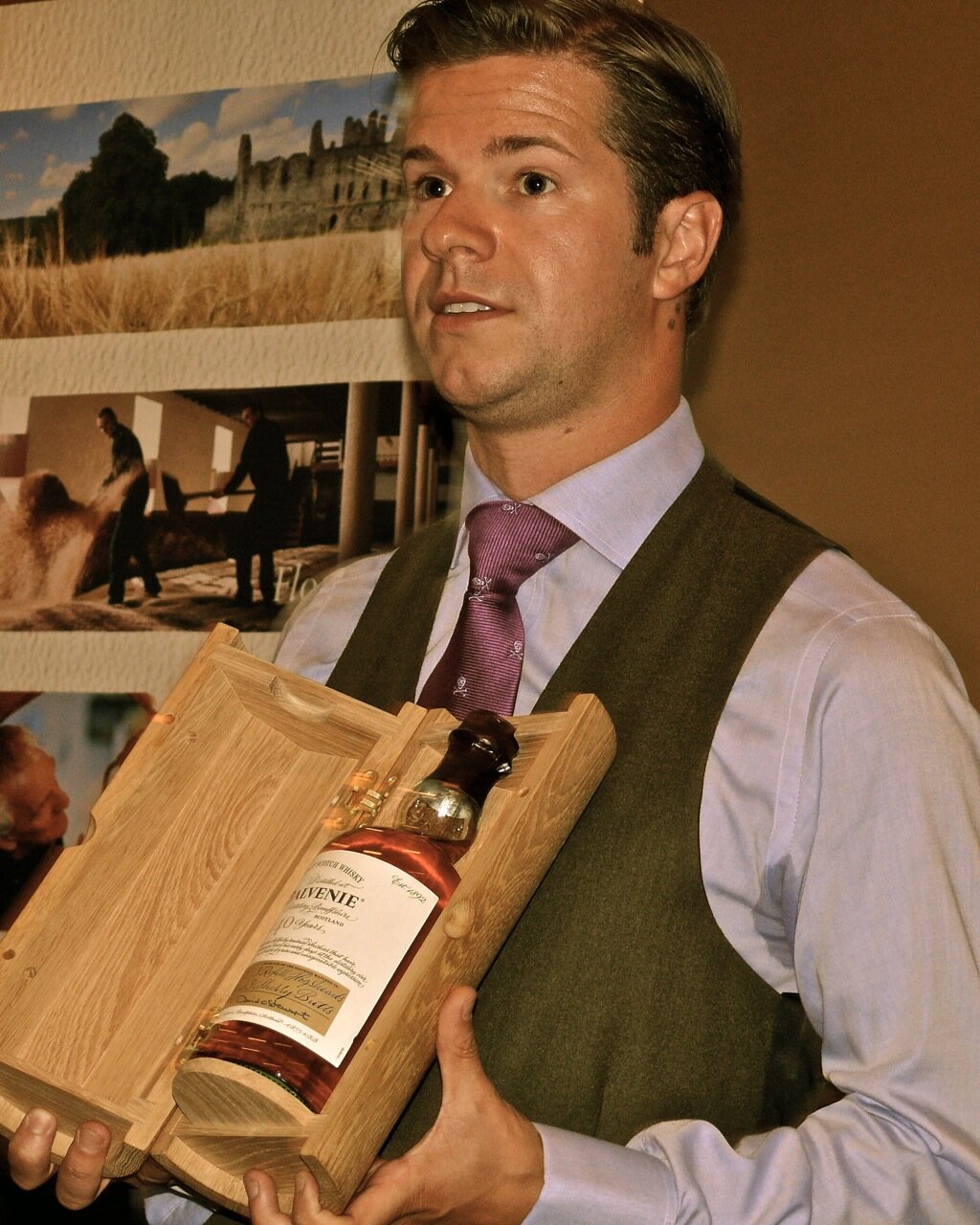
It’s not a bad life, Nicholas Pollacchi admitted. He’s driving a classic roadster, a handcrafted Morgan Plus 8, around the U.S. and drinking The Balvenie [Ball-VENN-ee] Scotch whisky with people, as part of a “nationwide voyage of discovery of rare American craftsmanship.” (The Morgan’s chassis is made of ash.)
The Balvenie Rare Craft Roadshow, as it’s called, is a year-long exploration and celebration of hand-crafted good things. Two Balvenie Ambassadors will be meeting up with people who still make things by hand: furniture, cowboy boots, cheese, suits, shoes…even boats. Pollacchi has seen stained glass in San Francisco, golf bags made in Lake Oswego, and stopped in at Gig Harbor to see some of Skip Fillippone‘s reclaimed creations at Filliqvist.
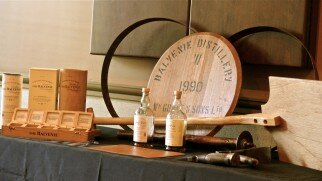 There’s a method to this mad pilgrimage–as Pollacchi explained to a group of Scotch drinkers at the WAC, in 1892, William Grant, with the help of seven sons, two daughters, and one stone mason, began turning the Balvenie mansion in Dufftown into a distillery. It’s not just the Scotch that’s handmade, it’s the distillery itself.
There’s a method to this mad pilgrimage–as Pollacchi explained to a group of Scotch drinkers at the WAC, in 1892, William Grant, with the help of seven sons, two daughters, and one stone mason, began turning the Balvenie mansion in Dufftown into a distillery. It’s not just the Scotch that’s handmade, it’s the distillery itself.
They’ve come a long way since–William Grant & Sons now owns Hendrick’s Gin, Milagro Tequila, Sailor Jerry rum, the blended Scotch Grant’s, and recently acquired Tullamore Dew Irish whiskey–but they’re still family-owned, on their fifth generation of Grant family management. Only Glenfiddich and Balvenie, of the 100-odd Scottish distilleries are still owned by the founding families, said Pollacchi.
Despite being the “second largest privately-owned business in Scotland,” employing over 1,000 people, with sales in 187 countries, William Grant & Sons never seems to have fallen under the spell of Frederick Taylor’s scientific management.

The Balvenie distillery has employed the same on-site coppersmith to make its stills for 51 years. Their malt master, David Stewart, has been making The Balvenie for 49 years. He’s the longest-serving malt master in Scotch whiskey history ever (“for one brand,” qualified Pollacchi)–next year he’ll be able to make a 50-year Scotch that he put into casks.
Pollacchi’s talk emphasized the continuity of experience at Balvenie, but it’s not just his opinion. About 350 people live in Dufftown, and 163 work at the Balvenie distillery. Presumably the rest work at one of the other 45 Speyside distilleries. The town’s site puts it like this:
Whisky making is the life blood of Dufftown. It involves every one from barley farmers to the Customs officers who ensure there are no irregularities with the duty due on the town’s spirits.
For Pollacchi–and one imagines, Maloney & Fox, the PR and marketing firm that represents the brand–the key differentiator is that Balvenie imperviousness to the quick and easy way. They grow a portion of their own barley on 1,200 acres near the distillery, they maintain an on-site cooperage to build their casks.
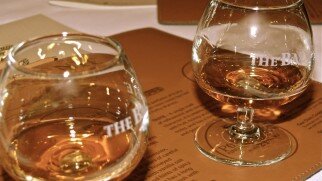 “65 to 80 percent of Scotch’s taste,” claimed Pollacchi, “comes from the maturation process in casks.” The vast majority of the industry uses ex-bourbon casks “because they’re cheap,” he said: a used bourbon cask will run you $60, while an Oloroso sherry cask sets you back $900. You can guess who’s proud of the extra investment.
“65 to 80 percent of Scotch’s taste,” claimed Pollacchi, “comes from the maturation process in casks.” The vast majority of the industry uses ex-bourbon casks “because they’re cheap,” he said: a used bourbon cask will run you $60, while an Oloroso sherry cask sets you back $900. You can guess who’s proud of the extra investment.
There’s also a hint of obsessiveness. Here’ s Pollacchi on malt master Stewart’s way of finding used rum casks:
David went out to the Caribbean and from seven or eight rum producers, he bought white rum. He shipped that white rum back to Scotland where he made his own rum blend. He then moved that rum from cask to cask to cask at our distillery, to season our wood. He then takes 14-year-old Balvenie from traditional whiskey casks, and finishes it in those Caribbean rum casks to give it that sweetness, and complexity, and flavor.
On the other hand, at the 2011 San Francisco Spirit Awards, the 14 Year Caribbean Cask won double gold, so don’t be second-guessing Stewart.
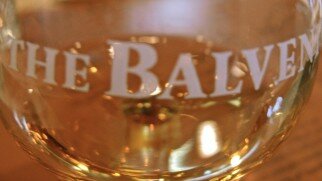 At the tasting at the WAC, in between cheap Scots jokes, Pollacchi schooled us on nosing and tasting Scotch, telling us to aim for a gentle wafting of the aroma, as if we were smelling a passerby’s perfume at the airport. Then, holding the glass, you place other tightly on top, and shake once or twice. With a be-Scotched palm, rub your hands together briskly, then cup them and inhale. When you actually taste the Scotch, let it have at your tongue a bit before swallowing, and then exhale so the “finish” rises to your nose–that’s when, with the Balvenie, you’ll get the smoky notes. (Speysides otherwise tend to lack that peaty campfire taste.)
At the tasting at the WAC, in between cheap Scots jokes, Pollacchi schooled us on nosing and tasting Scotch, telling us to aim for a gentle wafting of the aroma, as if we were smelling a passerby’s perfume at the airport. Then, holding the glass, you place other tightly on top, and shake once or twice. With a be-Scotched palm, rub your hands together briskly, then cup them and inhale. When you actually taste the Scotch, let it have at your tongue a bit before swallowing, and then exhale so the “finish” rises to your nose–that’s when, with the Balvenie, you’ll get the smoky notes. (Speysides otherwise tend to lack that peaty campfire taste.)
The Caribbean Cask is honeyed, fruity, but with a notably estery attack beneath the sweet. We also tried the Portwood 21 Year, the 2009 International Wine & Spirit Competition’s Best in Class, which is aged in traditional whisky casks, then finished for three to five months in vintage port casks (themselves 35 to 40 years old). The result is an involuntary eyebrow-raiser, as your tongue immerses itself in a flood of dark chocolate and raisin, vanilla and orange. A little pear comes on the back end.
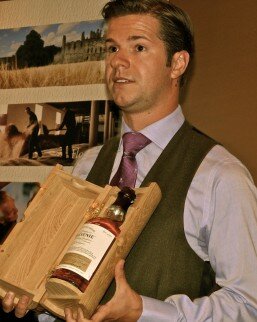
The Portwood 21 is remarkably balanced and bodied, and I would have left raving about that alone if, as a special treat, we hadn’t also been offered a dram of 40 Year. Only 150 bottles were made, 35 allocated to the U.S market.
It’s the union of six casks from 1970 (three oak, three sherry), and comes (of course) in a handmade wooden box. A bottle of it has sold for close to $4,000. The mouthfeel was like a non-viscous syrup, with the paradoxical sensation of a liquid melting on your tongue. It’s as close as you can come to drinking an oak tree’s blood, if you’re into that sort of thing. It’s less darkly fruited than the Portwood, still sweet, still floral, but with toffee and coffee in it.
The Caribbean Cask has not yet arrived, but the Washington State Liquor inventory of The Balvenie is not bad at all. You can search here, but a quick list and the retail price (with tax) is below:
- Doublewood 12 year $55.95
- 12 Year $60.95
- 15 Year $79.95
- 17 Year Rum Cask $129.95
- 17 Year Peated Cask $141.95
- Madiera Cask $141.95
- Portwood 21 Year $212.95
- Single Barrel 30 Year $483.90
